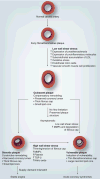Shear stress and plaque development
- PMID: 20397828
- PMCID: PMC5467309
- DOI: 10.1586/erc.10.28
Shear stress and plaque development
Abstract
Although traditional cardiovascular risk factors 'prime the soil' for atherogenesis systemically, atherosclerosis primarily occurs in a site-specific manner with a predilection towards the inner wall of curvatures and outer wall of bifurcations with sparing of flow-dividers. Wall shear stress is a frictional force exerted parallel to the vessel wall that leads to alteration of the endothelial phenotype, endothelial cell signaling, gene and protein expression leading to a proinflammatory phenotype, reduced nitric oxide availability and disruption of the extracellular matrix, which in turn leads to plaque development. Clinical and experimental data are emerging that suggest the pathobiology associated with abnormal wall shear stress results in atherosclerotic plaque development and progression.
Conflict of interest statement
The authors have no relevant affiliations or financial involvement with any organization or entity with a financial interest in or financial conflict with the subject matter or materials discussed in the manuscript. This includes employment, consultancies, honoraria, stock ownership or options, expert testimony, grants or patents received or pending, or royalties.
No writing assistance was utilized in the production of this manuscript.
Figures





References
-
- Ross R. Atherosclerosis – an inflammatory disease. N Engl J Med. 1999;340:11–26. - PubMed
-
- Van der Laan P, Reardon C, Getz G. Site specificity of atherosclerosis site-selective responses to atherosclerotic modulators. Arterioscler Thromb Vasc Biol. 2004:12–22. - PubMed
-
- Nichols W, O’Rourke M. McDonald’s Blood Flow in Arteries: Theoretical, Experimental and Clinical Principles. 5th. Hodder Arnold Publications; London, UK: 2005.
-
- Slager CJ, Wentzel JJ, Gijsen FJH, et al. The role of shear stress in the generation of rupture-prone vulnerable plaques. Nat Clin Pract Cardiovasc Med. 2005;2:401–407. Excellent review of the pathobiology of plaque development and the generation of rupture-prone vulnerable plaques. - PubMed
Publication types
MeSH terms
Substances
Grants and funding
LinkOut - more resources
Full Text Sources
Other Literature Sources
Medical
